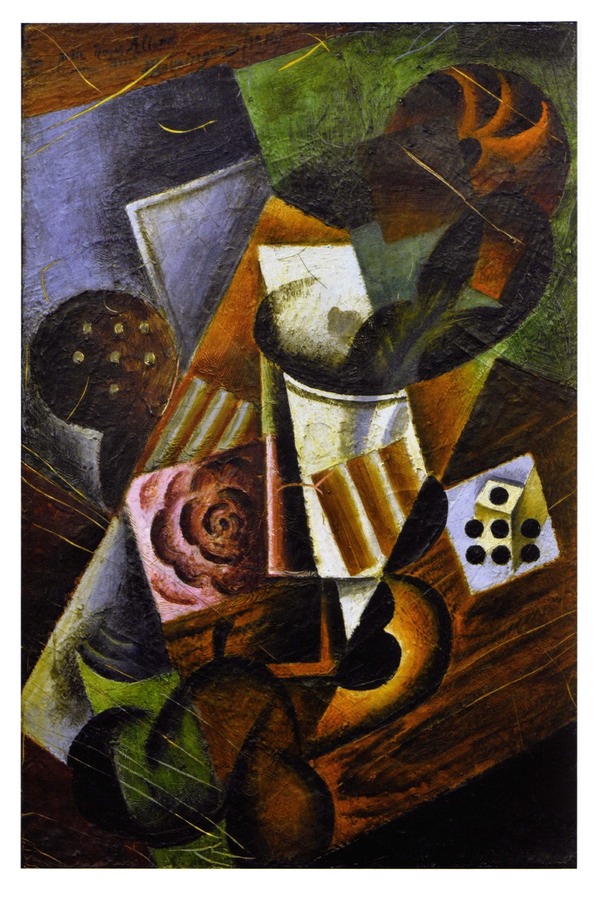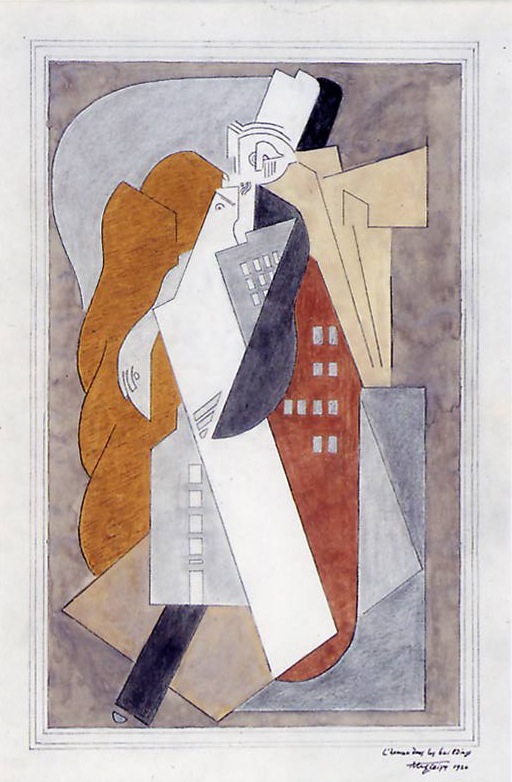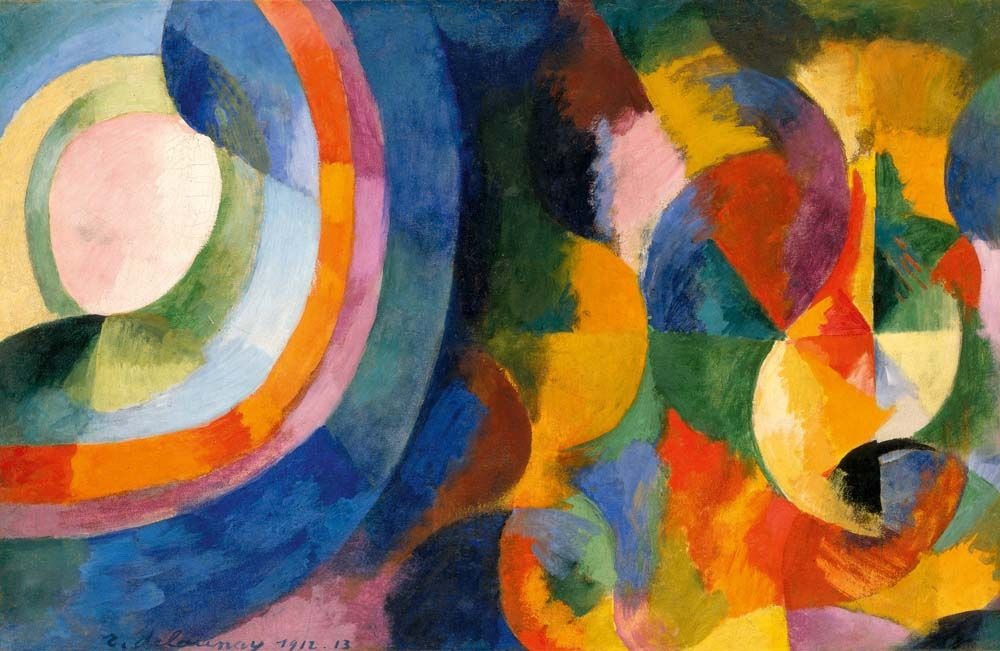CUBISM AS A CONSTRUCTIVE FORCE
Gleizes describes what happened in a lecture given in 1931 under the title Art et religion. Cubism starts with a desire to affirm the reality of the subject in its most brutal three dimensional form, hence the 'cube'. It is a reassertion of the classical principle of three dimensional form in reaction to the nebulosity of the Impressionists, Neo-Impressionists (pointillisme) and Fauves. It is - and this is its greatness and importance - a research into form, as opposed to the Impressionist and Post Impressionist emphasis on colour. But the form of the subject, the external appearance, has become suspect. In the age of cinema its eternally frozen nature feels wrong. The fact that, like a photograph, it is only ever seen from one angle, seems false to our actual experience as we move and as the subject moves - an extension of Monet's awareness of the way in which what appears before his eyes changes according to changes in the light. Hence the abandonment of single point perspective and the desire to show the subject from different angles simultaneously. But this, as Gleizes points out, posed radical problems for the construction of the panting, no longer determined by the form of the thing to be depicted, the subject:
'However, to cobble the fragments together more or less competently we were obliged to take the natural requirements of our canvas or of our panel into account. These fragments of images in fact held together by virtue of the plane surface which supported them. We used vertical, diagonal or horizontal lines to limit one fragment of description and we then went on to register the next fragment in the same way, and so on.... Can you see the quid pro quo that was taking place? On the one hand a descriptive method dependent on external phenomena; on the other a real, authentic method born from a particular plastic fact — the plane, which imposed its formal nature on our attempts to draw the characteristics of something that takes place under completely different plastic conditions. From this quid pro quo a complete transformation of the classical understanding of form had to emerge.' (11)
(11) Albert Gleizes: Art et Religion, Art et Science, Art et Production, Chambéry, Editions Présence, 1970. In English, translation with introduction and notes by Peter Brooke, as Art and Religion, Art and Science, Art and Production, London, Francis Boutle publishers, 1999, p.36.
It may be noted here that for Gleizes the breakthrough came, not in his own work but in the work of the painters who had remained in Paris during the war. The war had torn what we might call the original Cubist community apart. By a curious chance, the painters most resistant to the influence of Picasso and Braque were scattered. Gleizes, Léger, Villon (Jacques Villon, nom de plume of Gaston Duchamp) and Villon's brother, the sculptor Raymond Duchamp-Villon, were called up. Duchamp-Villon was killed. Léger and Villon continued in the army through the war (as did Picasso's closest associate, Braque). Gleizes was released from military service in 1915 but then went to New York, where he joined Picabia and the third and youngest of the Duchamp brothers, Marcel. Robert and Sonia Delaunay took refuge in Spain.
The painters who remained in Paris were largely foreigners, not liable for military service - Picasso, the Italian Gino Severini, the Spaniard Juan Gris, the Mexican Diego Rivera. Jean Metzinger was called up but served in a hospital as a medical orderly and from 1916 was stationed in Paris and able to paint. The Cubist cause was maintained financially through the faith and generosity of the great (and under-appreciated) art dealer, Léonce Rosenberg.

Jean Metzinger: Homage to the poet Roger Allard, 1916
For Gleizes it was in the wartime work of Metzinger and Gris that a clear principle of construction was beginning to emerge. This was rendered easier because they, impressed by the work of Picasso and Braque (and, apparently, failing to notice the Nihilist revolution accomplished according to Rookmaaker by Picasso) were following them in using the simple, neutral subject matter of the still life. Gleizes in New York was still working on ambitious, large scale subjects, vividly impressed by the pictorial impact of New York itself. He criticised the subject matter of his friends still in Paris in a letter to Henri-Martin Barzun (father of the philosopher Jacques Barzun):
'We are in the age of synthesis. An hour in the life of a man today raises more levels, insights, actions, than a year of that of any other century. That is what I try to say in my art. The rapid sketch of an Impressionist crystallised the fragility of a sensation; it was immobilised in his picture. The painting of today must crystallise a thousand sensations in an aesthetic order. And I see that for that there is no need to reveal other laws, other theorems with definitive forms. A beauty achieved through a mathematical order can only have a relative life; the universal kaleidoscope cannot be fitted into the framework of a system; it surprises through the unforeseen and is renewed by it. We should regard 'the system' with suspicion. It limits our possibilities. How, for example, can we give the equivalent of the enormous 'Broadway' – that fantastic river with a thousand currents going against each other, interweaving, rising up over its banks – if, in our painter's expression, we apply little principles just about good enough to describe a very simple object, an inkstand, a box etc. With one blow, the truth dazzles us [crève les yeux] and rises up to scatter the system's charm ...' (12)
(12) Albert Gleizes to Henri-Martin Barzun, 24/8/1917. I consulted a typescript copy. The original is in the H-M Barzun archive in Columbia University.
Yet it was these 'little principles just about good enough to describe a very simple object, an inkstand, a box etc.' that were to become the basis of his own teaching in the 1920s, summed up under the terms 'translation' and 'rotation'. This was an organisation of the painting on the basis of vertical and horizontal planes ('translation'), affirming a principle of stability, and planes inclined to the right and to the left ('rotation'), thus precipitating the eye into a movement round the surface.

Albert Gleizes: Man in his buildings, 1920
What was happening was that the attempt to take account of movement in the appearances of the external world had become an actual movement on the part of the viewer - not because the viewer physically moves but because movement is a property of human consciousness. An act of observation and analysis - that's a house, and that's a horse, and that's a tree, and that signifies wealth, the horror of war, the joy of childbirth - has become a participation (Gleizes was later to call some his paintings Supports de contemplation) as the viewer follows the painting's interaction of stability and mobility. As Gleizes's pupil, the potter Anne Dangar, was to put it: 'Every line, every colour, every shape, comes from somewhere and goes somewhere.' (13) Which means that, ultimately, the movement of the painting has to be circular, since the moment it passes outside the overall limits, the frame, of the painting the movement stops. The circle - understood as a movement from one thing to another, a series of cadences, not as a static geometrical figure - thus became for Gleizes the key to understanding the mystery of form, hence his admiration for the pre-war 'circular forms' of Robert Delaunay:
'Robert Delaunay even had the intuition of a synthetic form which would replace the form which remains static and fragmentary, whether it is shown in perspective unity or in a multiplicity of points of view. Of course he is still in space, he is still too visual, of that there is no doubt; he is too much dominated by the play of sensory impressions but, nonetheless, he suspects the existence of something new; he begins to touch it, he proclaimed it aloud in his Disques Simultanés. And that seems to me to be profoundly moving nowadays, when I believe that I have good reasons for understanding what I could not grasp then [...] As for myself, I admit that the more I deepen my understanding of the problem of form posed categorically by Cubism in 1911, the more Delaunay’s work reveals its worth. And that is why I conclude, freely, that among all of us at that time, it was he, sustained solely by gifts of the first order and by his own abundant high spirits, who came closest to the truth.' (14)

Robert Delaunay: Sun/moon, simultaneous no 1, 1913
(13) I have this from Anne Dangar's pupil Genevieve Dalban.
(14) Albert Gleizes: ‘L’épopée, de la forme immobile à la forme mobile’, Le Rouge et le Noir, 1929. Reprinted in Puissances du Cubisme, Chambéry, Editions Présence, 1969. English translation: The Epic, From Immobile Form to Mobile Form, Ampuis, Association des Amis d’Albert Gleizes, 1995. It can also be found on my older website at http://www.peterbrooke.org.uk/a%26r/gltexts/texts